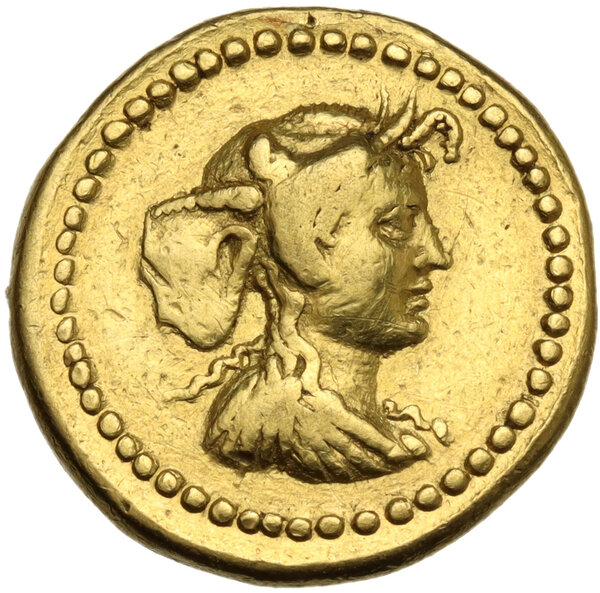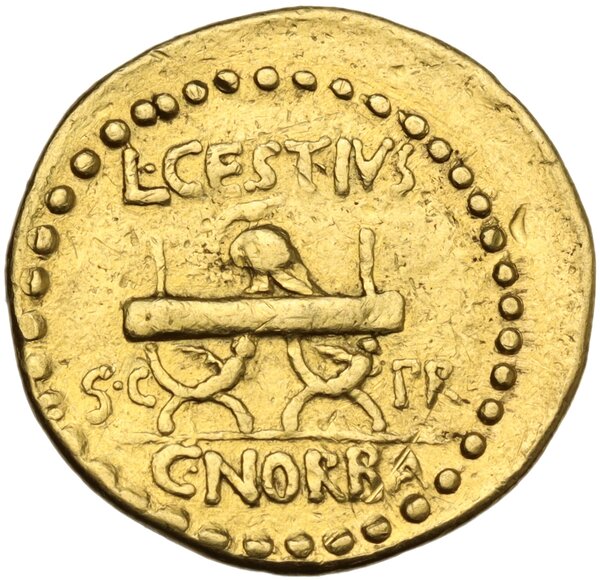Cestius and Norbanus Aureus


Lot 418:
L. Cestius and C. Norbanus. AV Aureus. Rome mint, January-April 43 BC. Obv. Draped bust of Africa right, wearing elephant skin headdress. Rev. Corinthian helmet set atop curule chair, legs decorated with eagles; CESTIVS above, C•NORBA below, S•C - PR across fields. Cr. 491/1a; B. Cestia 1 and Norbana 3; Bahrfeldt 24; Calicó 3a. 8.01 g. 19.50 mm. RR. Very rare. Perfectly centred on a broad flan. Rough surface with marks. About VF/VF. Dating and interpreting this aureus has proved troublesome in part due to its imagery. It is the second aureus type in a series which complicates more than it enlightens, and the lack of information regarding Cestius and Norbanus themselves hinders us considerably. The most likely explanation according to Sear (The History and Coinage of the Roman Imperators) is that this aureus was an emergency issue of the Senate in 43 BC, in response to Antony having marched his legions towards Cisalpine Gaul which he had demanded be given to himself despite it already being governed by Decimus Brutus. Antony's actions were condemned by the Senate which, swayed by Cicero, allied itself with Octavian thus legalising any military action he and his troops might take against Antony, who was promptly declared a public enemy. If indeed this aureus was thus minted to pay for the Senate's legions, then it is suggested by Sear and Crawford that the elephant skin headdress should be assumed to be a reference to the troops themselves, possibly being units hastily withdrawn from the province of Africa.
The presence of the Corinthian helmet on the reverse of our current coin has not yet been fully explained. Sear has suggested it is symbolic of Minerva, goddess of war, particularly since CRI 195a replaces the helmet with snakes, also a symbol of Minerva. It is tempting however to see in the reverse image a powerful symbol of the times – by March of 43 BC both consuls had marched north with their legions, leaving the consuls' chairs in Rome empty, replaced on these coins by symbols of war. Indeed both consuls, Hirtius and Pansa, would be mortally wounded in battle against Antony, leaving the consulship vacant for nearly four full months from April 21 until Octavian was sworn in on August 19.
This coin is paired with an aureus also issued by Cestius and Norbanus which depicts the bust of Sibyl(?) on the obverse and a cart driven by Cybele on the reverse (Crawford 491/2, CRI 196). The iconography of that type is perhaps even less well understood than that of the present, and further complicates an already difficult interpretation. As for the moneyers themselves, Appian mentions a Cestius who was proscribed following the foundation of the first triumvirate (Civil War 4.26) and, like Cicero, came to a sudden end; C. Norbanus may have survived his colleague and may be the same C. Norbanus C. f. Flaccus who held the consulship in 38 BC. (Roma Numismatics 16, 2018, lot 619 note).
The presence of the Corinthian helmet on the reverse of our current coin has not yet been fully explained. Sear has suggested it is symbolic of Minerva, goddess of war, particularly since CRI 195a replaces the helmet with snakes, also a symbol of Minerva. It is tempting however to see in the reverse image a powerful symbol of the times – by March of 43 BC both consuls had marched north with their legions, leaving the consuls' chairs in Rome empty, replaced on these coins by symbols of war. Indeed both consuls, Hirtius and Pansa, would be mortally wounded in battle against Antony, leaving the consulship vacant for nearly four full months from April 21 until Octavian was sworn in on August 19.
This coin is paired with an aureus also issued by Cestius and Norbanus which depicts the bust of Sibyl(?) on the obverse and a cart driven by Cybele on the reverse (Crawford 491/2, CRI 196). The iconography of that type is perhaps even less well understood than that of the present, and further complicates an already difficult interpretation. As for the moneyers themselves, Appian mentions a Cestius who was proscribed following the foundation of the first triumvirate (Civil War 4.26) and, like Cicero, came to a sudden end; C. Norbanus may have survived his colleague and may be the same C. Norbanus C. f. Flaccus who held the consulship in 38 BC. (Roma Numismatics 16, 2018, lot 619 note).
Start price € 4000
Current price € 4800
Bids: 6
No more available for sale.
Current price € 4800
Bids: 6
No more available for sale.





